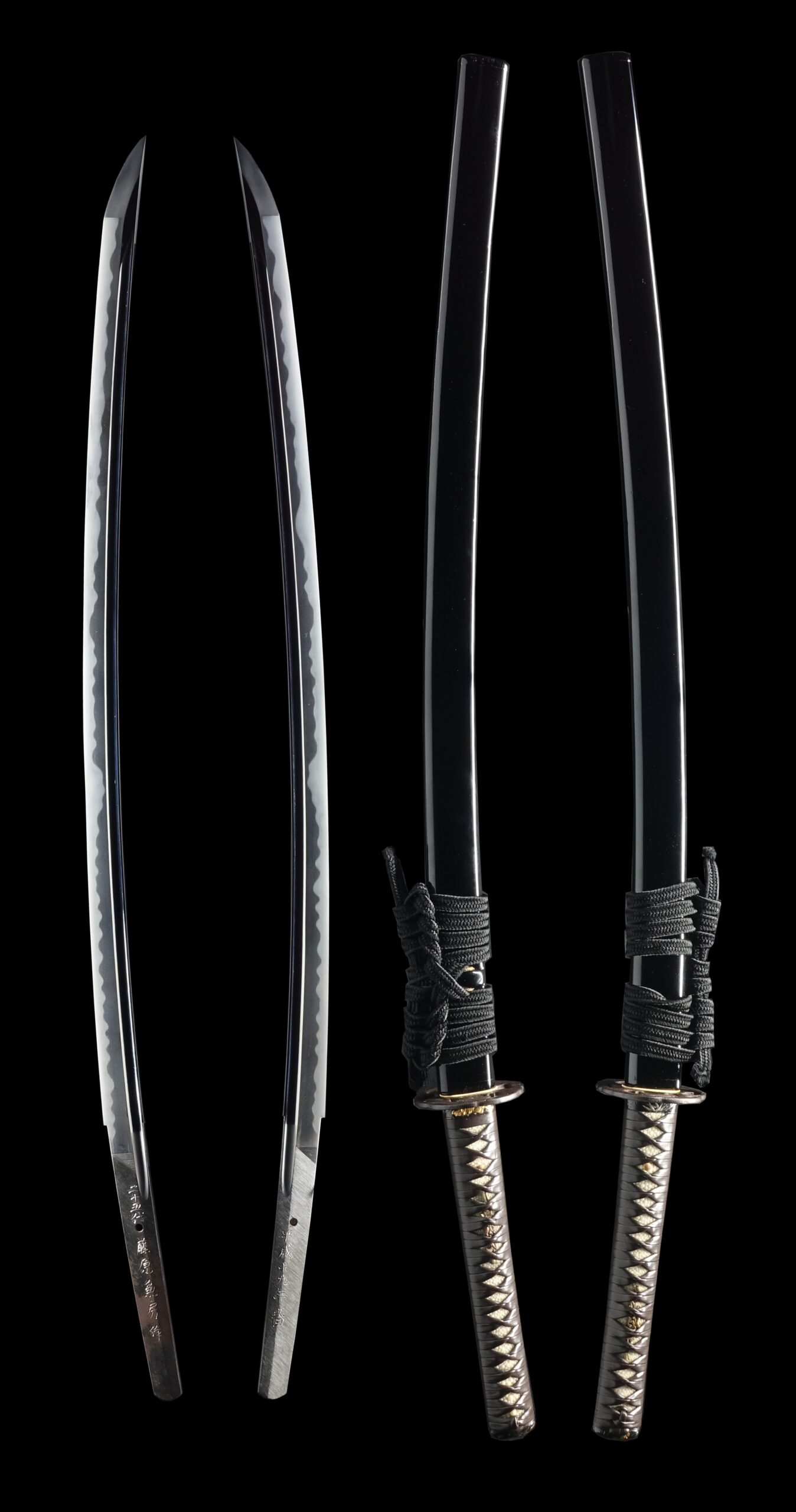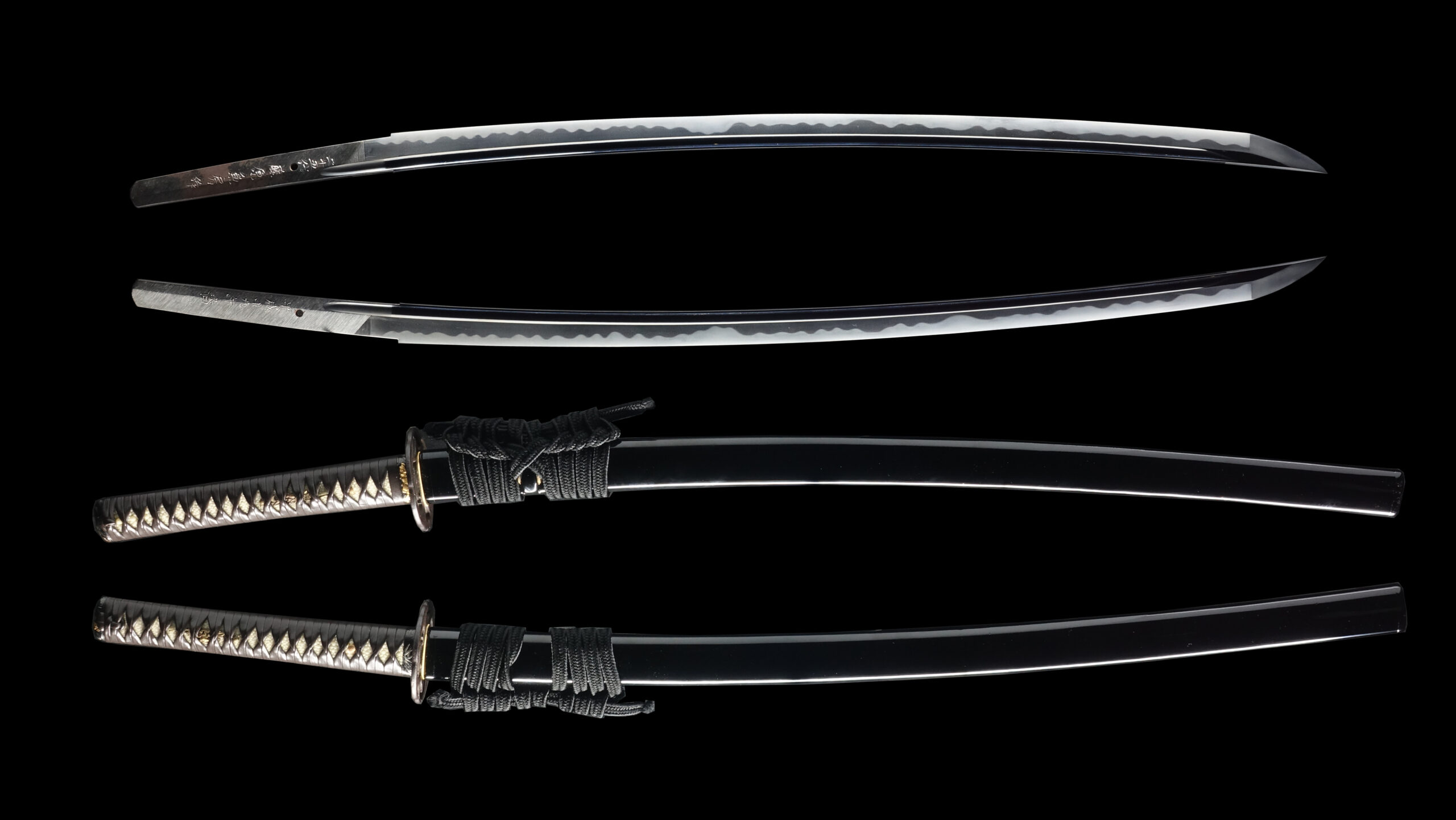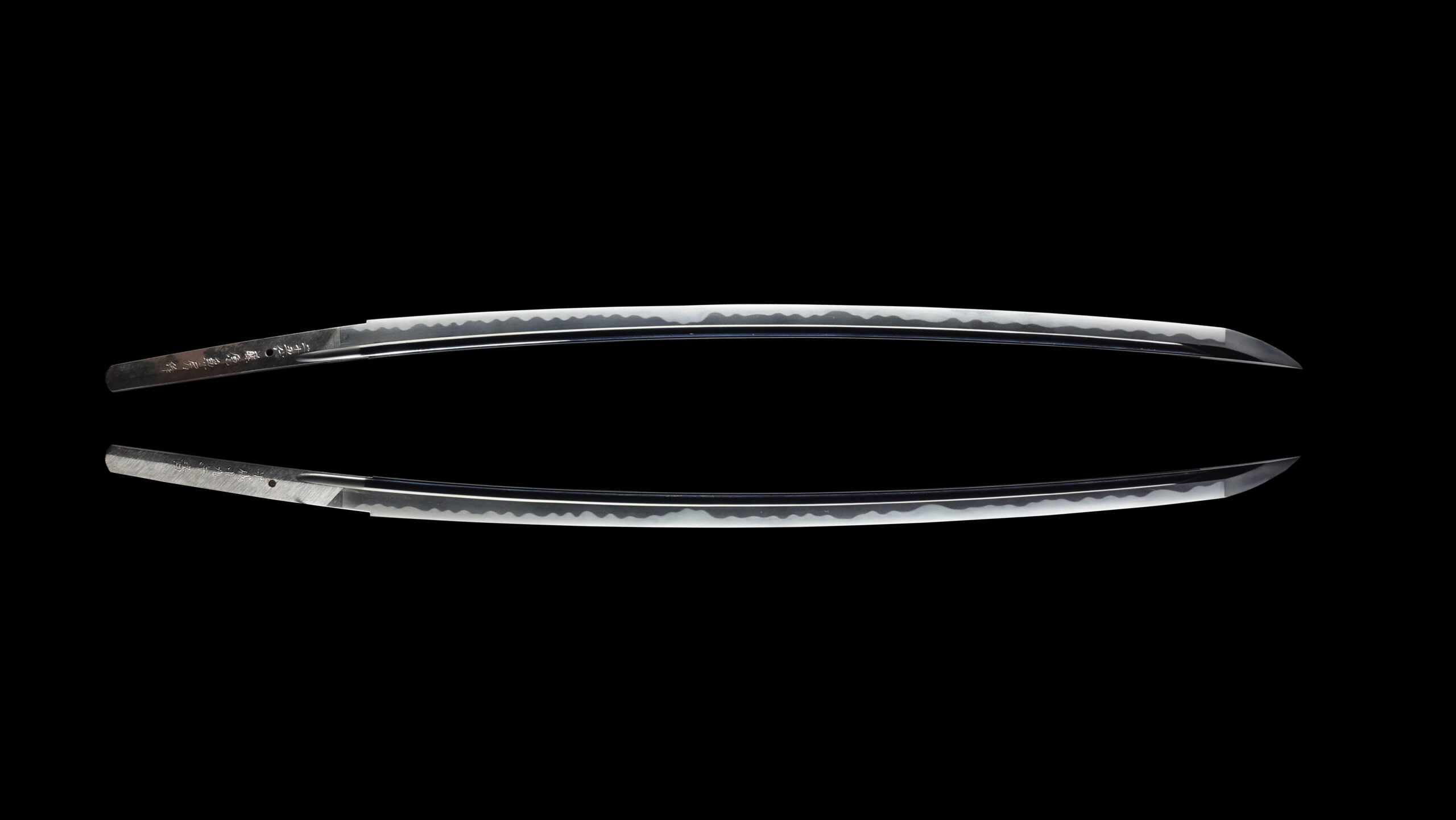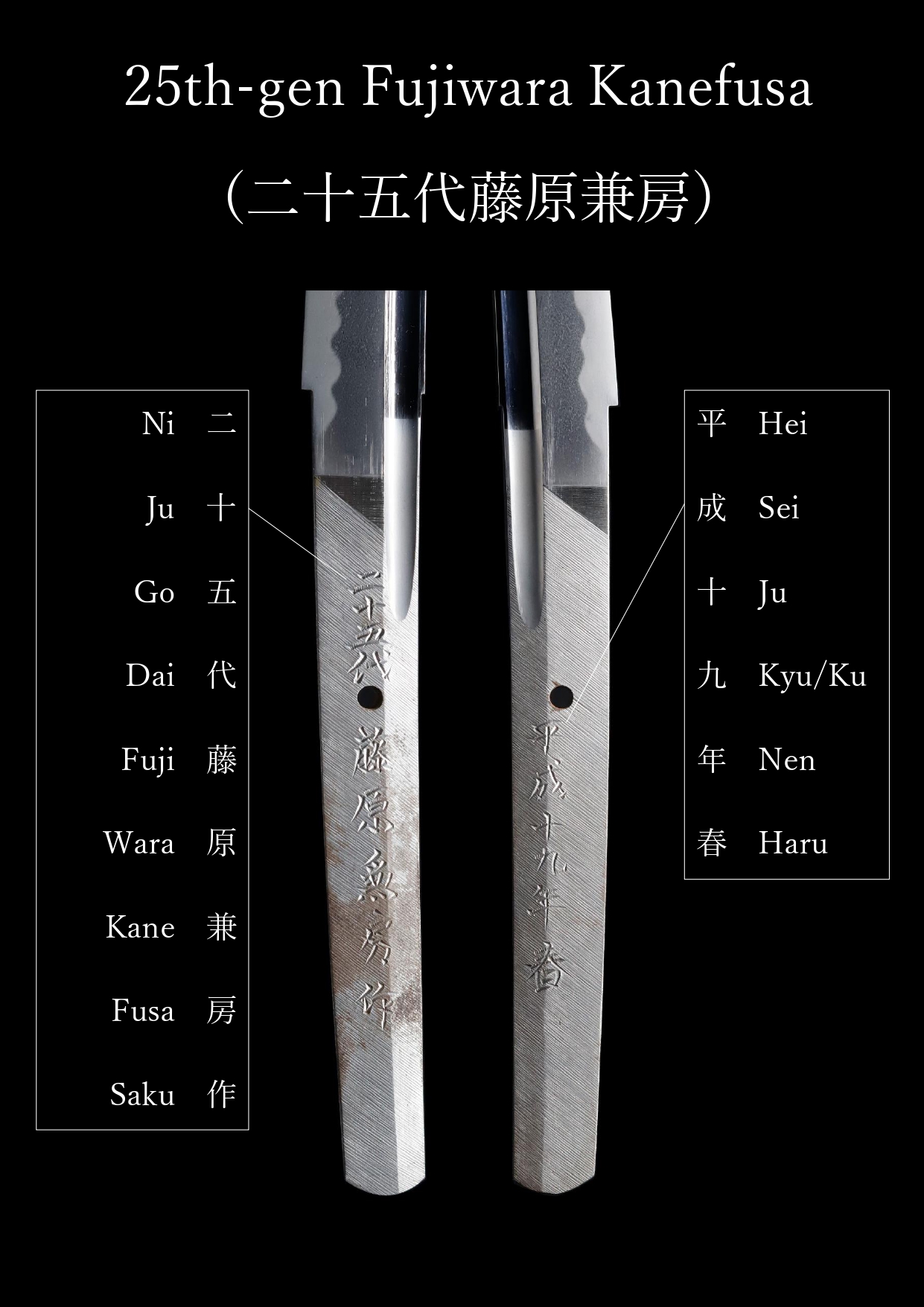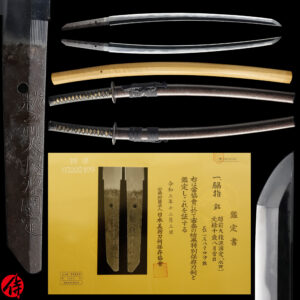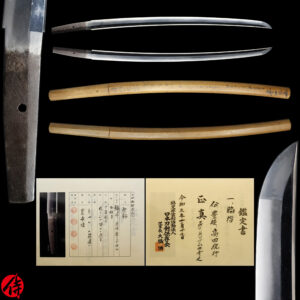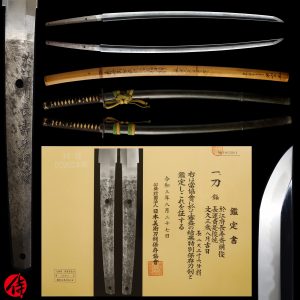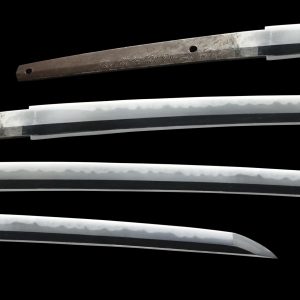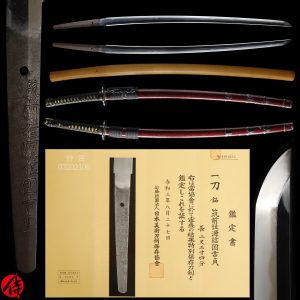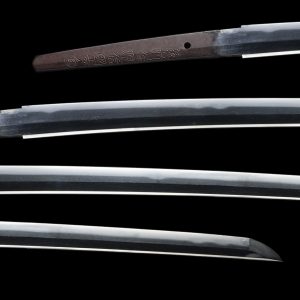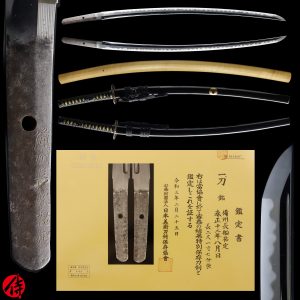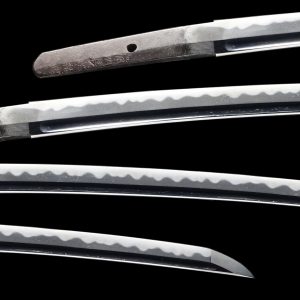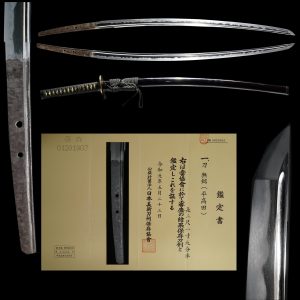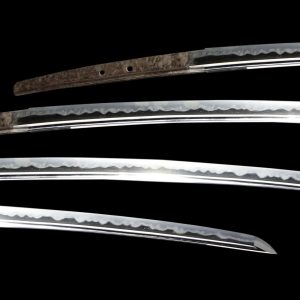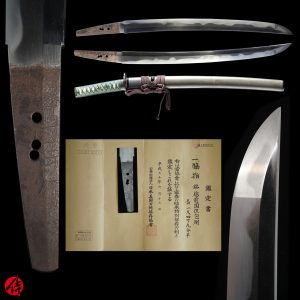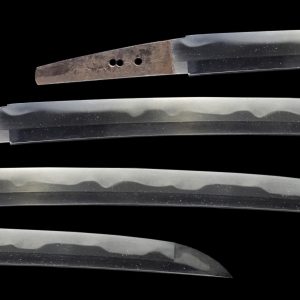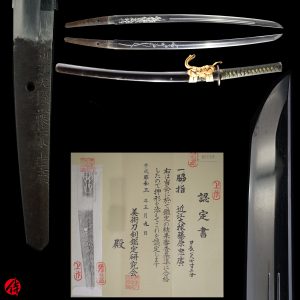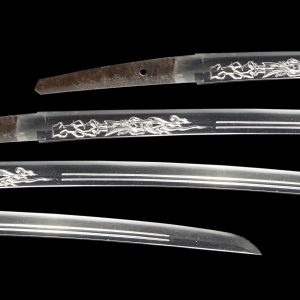Modern Authentic Japanese Sword Katana Signed by the 25th-gen Fujiwara Kanefusa
【Description】
This blade was signed by the 25th-gen Fujiwara Kanefusa (二十五代藤原兼房) in the 19th year of the Heisei era (2007). The maker’s name, Kanefusa, has been passed down since the mid-Muromachi period (Early 15th century). The first-gen Kanefusa was one of the most famous makers in Mino province (today’s Gifu prefecture) during the Muromachi period.
The swordsmith who created this blade was born in Gifu prefecture in 1957 as the second son of the 24th-gen Kanefusa. His birth name is Kato Katsuo. He grew up seeing the craftsmanship of his grandfather (23th-gen Kanefusa). In 1975 as soon as he graduated from high school, he became an apprentice of Gassan Sadakazu, a living national treasure of Japan back then. Kanefusa finished his apprenticeship after eight years of practice. He was able to master his master’s superb level of sword-forging skills as well as engraving skills.
In 1982, he passed the national exam to legally forge Japanese swords, which was held by the Agency for Cultural Affairs(Bunka-Cho) and received a legal license. In the same year, he participated in an event held by the Boston Museum of Fine Arts, where the museum featured his master, Gassan Sadakazu, as a living national treasure of Japan. He helped his master and showed the American public how to forge the Japanese sword traditionally. In 1983, he started to work for his father, 24th-gen Kanefusa. And he became an independent swordsmith, running his school the following year. This is the time he was allowed to use 25th-gen Kanefusa as his maker’s name.
He has received multiple awards at Shinsaku Meito Ten in his career, where modern Japanese swordsmiths compete in their craftsmanship. He forged a blade for an imperial family member and dedicated his creation to Yasukuni shrine and Atsuta shrine, one of the most honorable achievements for a modern swordsmith. He also created a Tachi blade for Yokozuna, the top ranker of Sumo wrestling in Japan.
Kanefusa played an essential role for the swordsmiths living in Gifu prefecture, especially Seki city. He oversees two organizations whose mission is to preserve the traditional sword-forging techniques that have been passed down in Seki City. He has been enthusiastic about introducing the Japanese sword to other countries. In 2004, he held an event in Russia and Germany.
*This blade comes with a modern Koshirae (sword mounting) because its previous owner used for his Iaido practice.
About Modern Swordsmith
There are around 150-200 swordsmiths in Japan today. To legally produce Japanese swords, one needs to pass the national exam given by the Agency for Cultural Affairs(Bunka-Cho) and receive the license. Before taking the exam, one must finish his or her apprenticeship under a licensed master for more than five years. Those who practice Iaido(居合道) tend to use those modern swords, and there are modern Japanese sword collectors nationwide.
Modern Japanese sword makers are researching old ways to forge swords and trying to recreate ancient-style swords. They are the ones who keep the tradition of Japanese history alive.
【 Blade】
Cutting Edge Length(Nagasa): 71.0 cm (27.9 inches)
Curvature(Sori): 2.0 cm (0.79 inches)

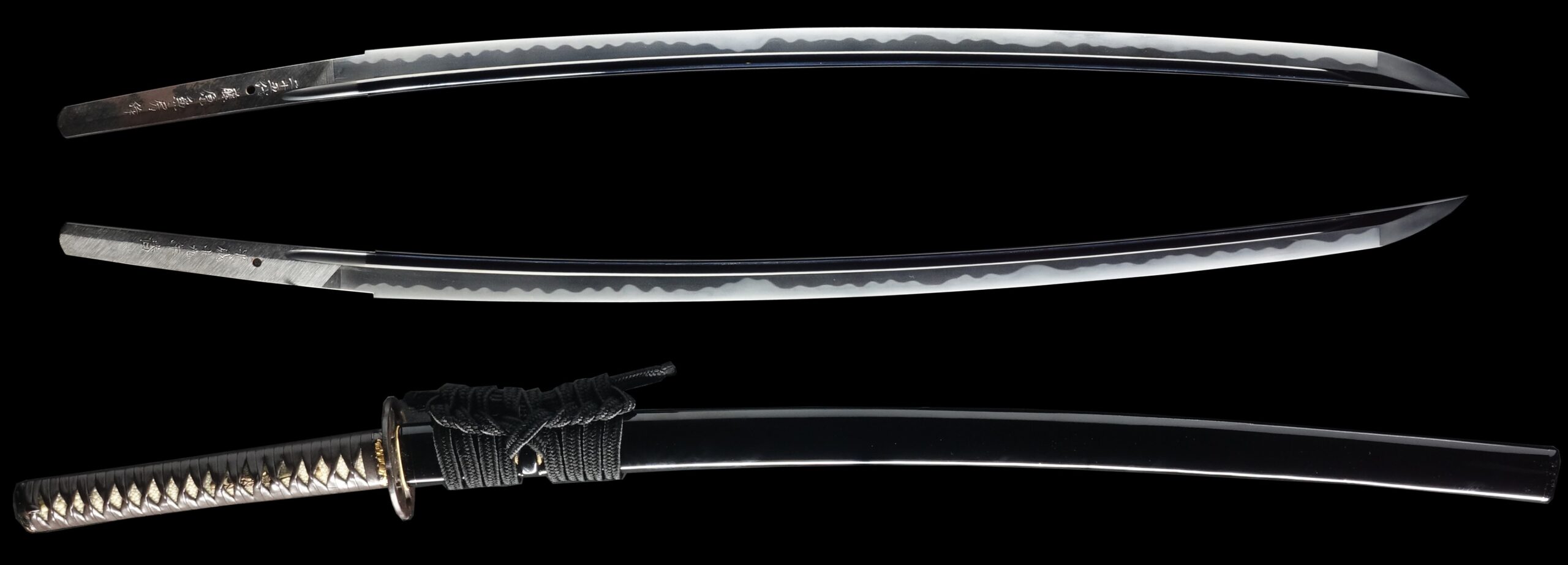
Hamon:
The crystalline structure which forms along the cutting edge of a blade as a result of the hardening process
Jimon(Jihada):
visible steel surface pattern created by folding and hammering during forging process
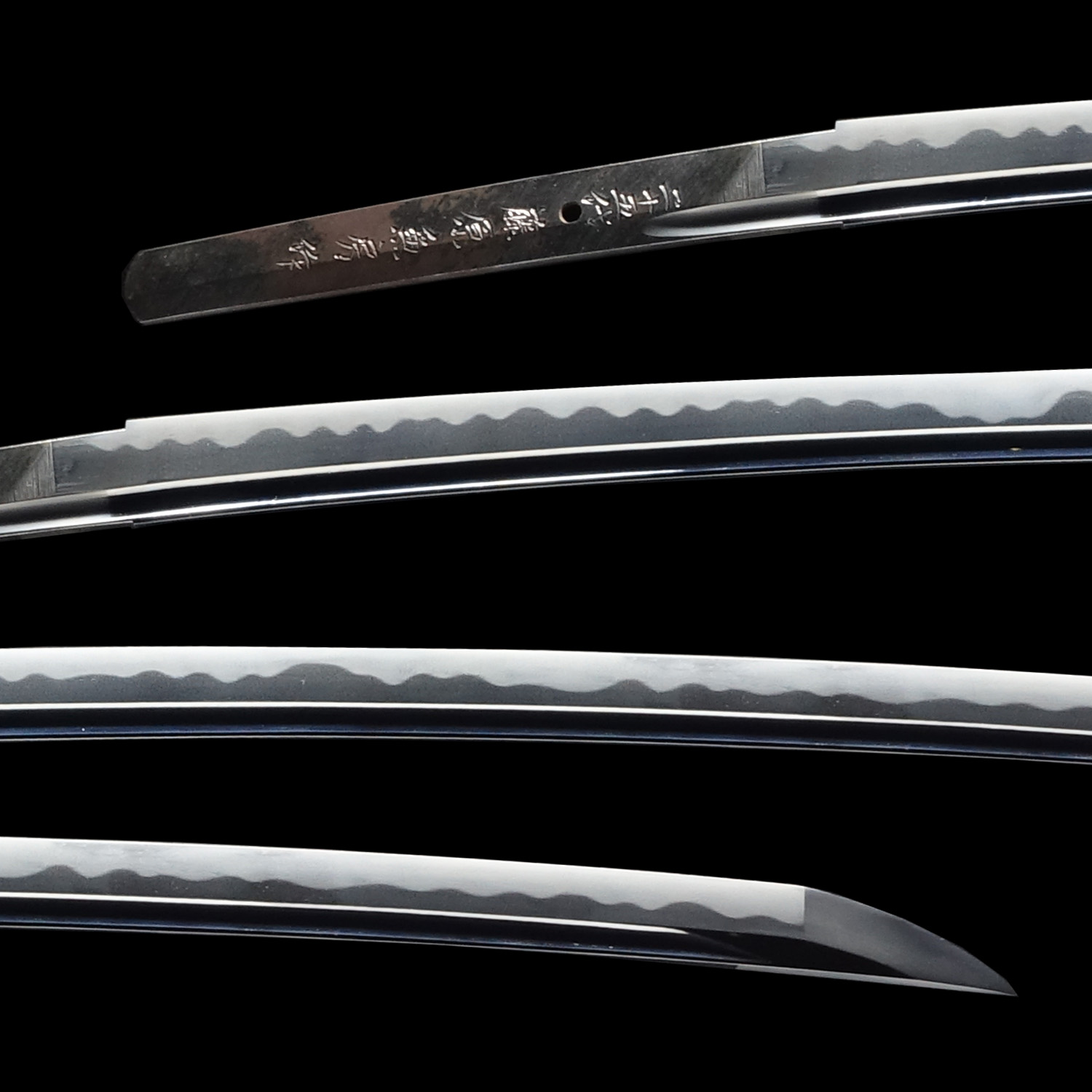
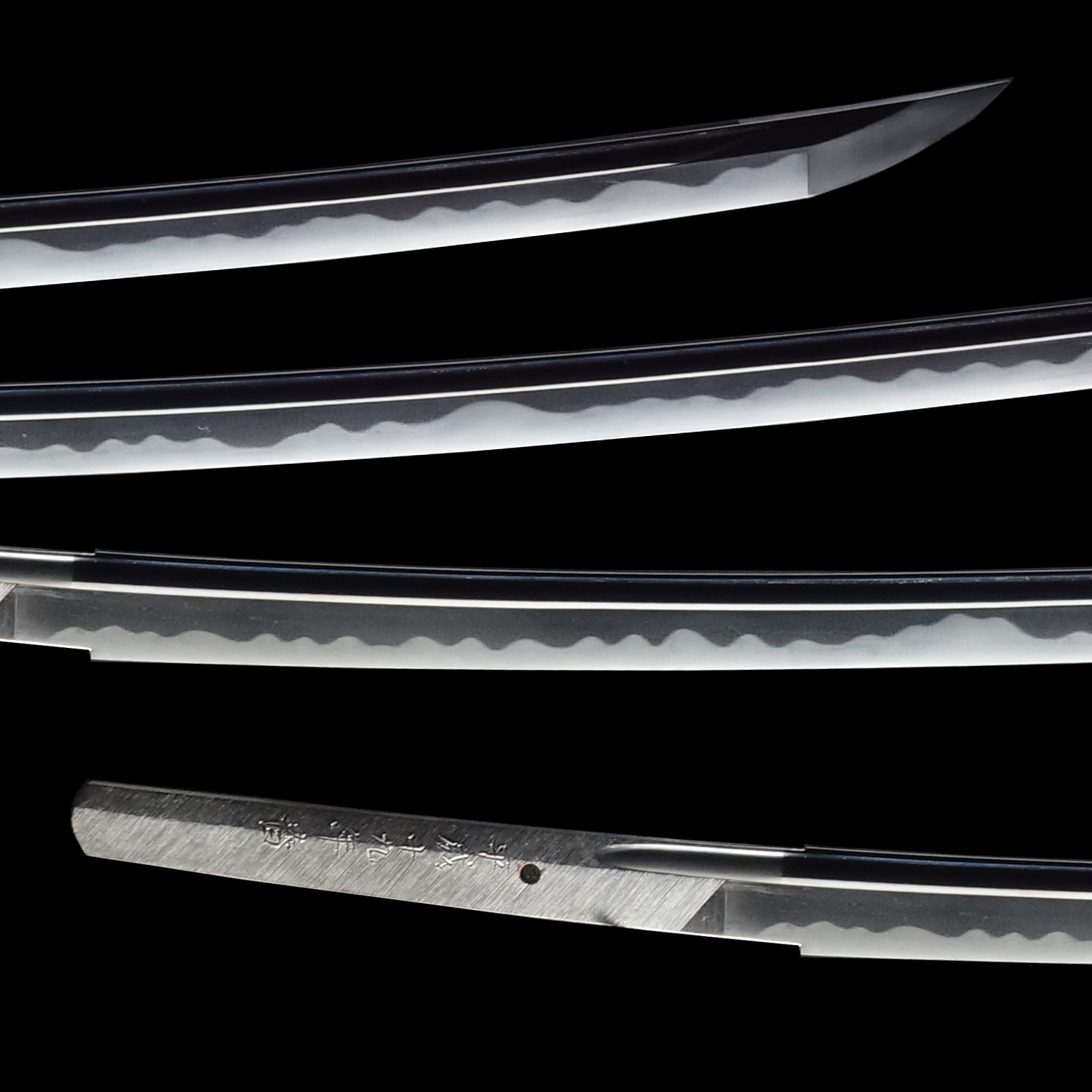
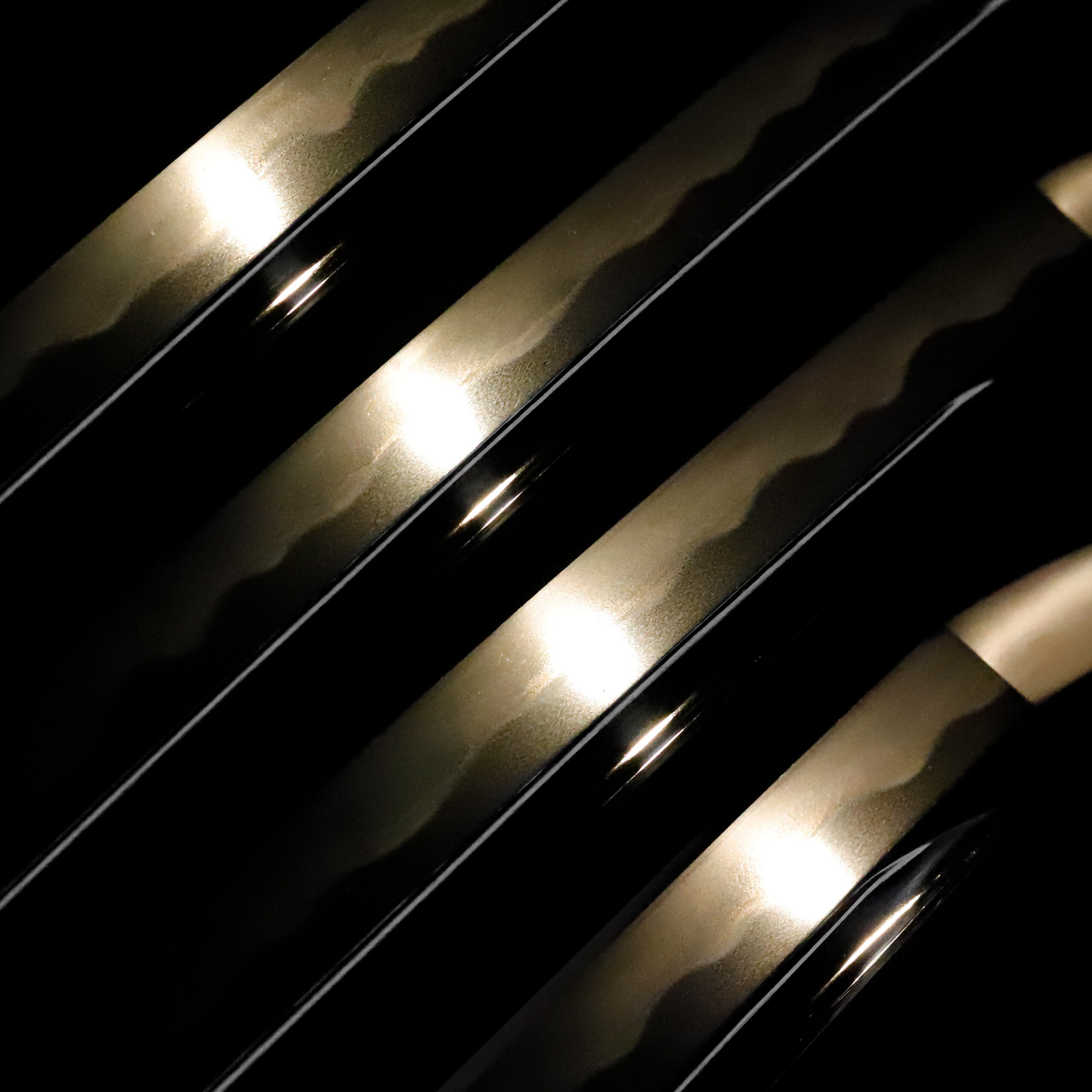
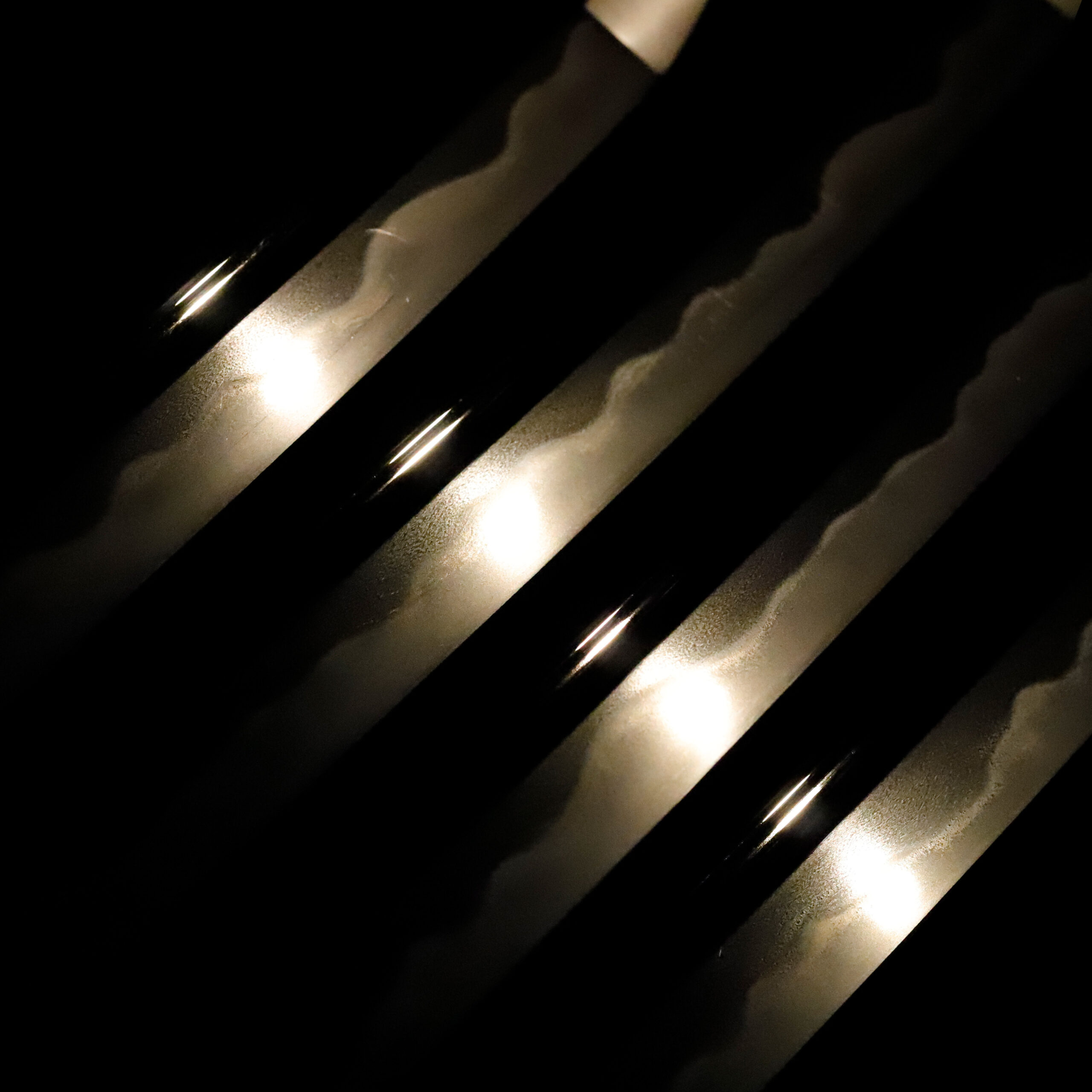


Nakago:Nakago is the tang of the Japanese sword.
Japanese swordsmiths left the black rust on the tang because it prevents red rust while the tang is in its handle. And the discoloration of the tang was created over time, and it is a great indicator for a Japanese sword specialist to estimate when the sword was forged.
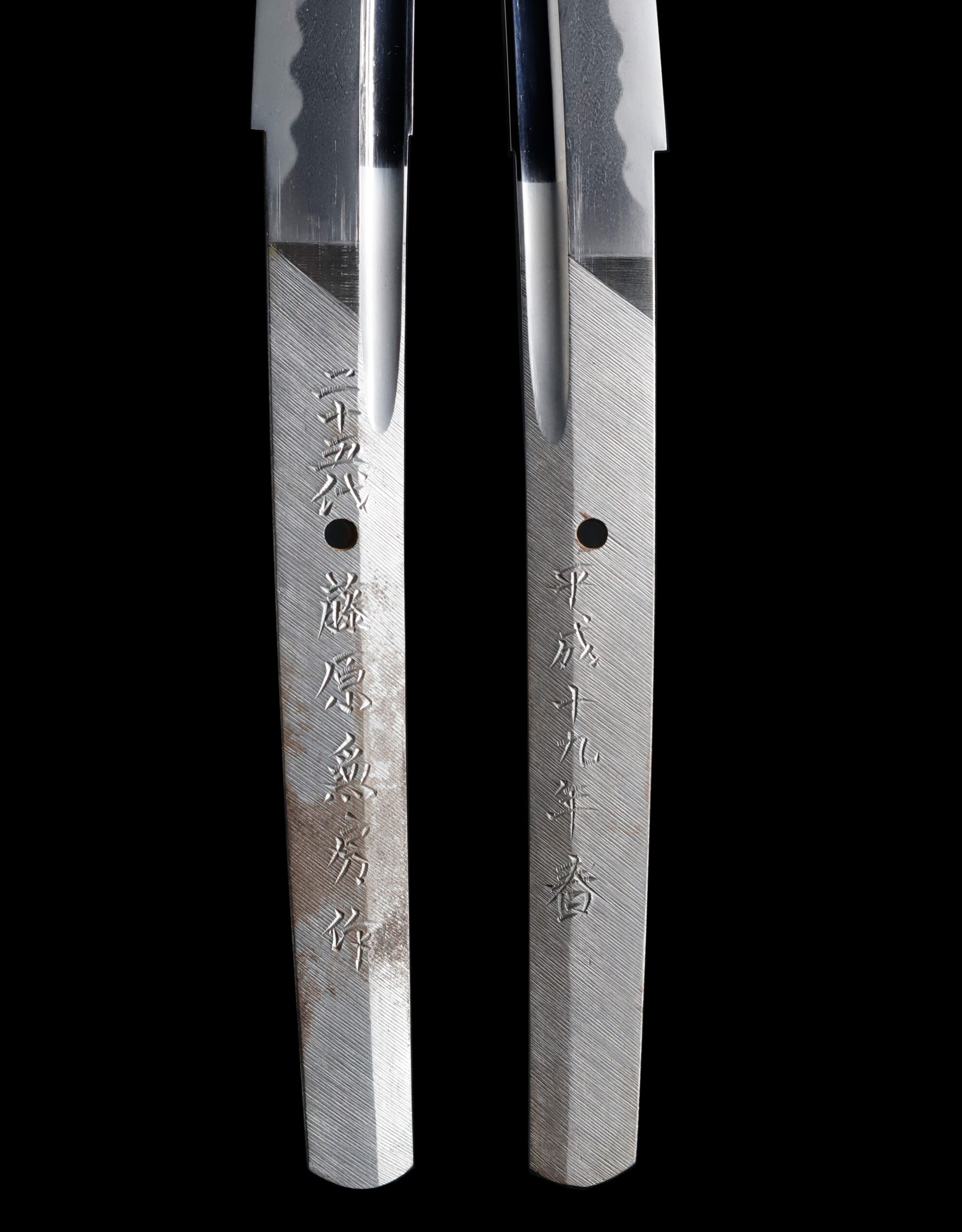
Koshirae: Koshirae is the mounting of the Japanese sword. There are several parts that consist of Koshirae such as Saya(Scabbard), Tsuka(Handle), Tsuba(Handguard).

Fuchi-Kashira:A pair of matching sword fittings that cover the upper and bottom parts of its sword hilt.
The motif of this Fuchi Kashira is the Tora (虎/寅, tiger). Golden paint is applied to these dragons, and this coloring adds decorativeness to this work. As the saying goes, “A tiger travels a thousand miles in a day and returns a thousand miles.” It is said that with its strong vitality shakes off all kinds of disasters and leads to prosperous family fortunes. In addition, the tiger facing forward is said to be a “tiger of all directions.” It is drawn as if it is glaring at a foreign enemy to prevent disaster from approaching, and it has the meaning of an amulet and exorcism.
This animal is known as a member of the Junishi (十二支, the twelve signs of the Chinese and Japanese zodiac). There are various theories about the details of the Junishi legend. Its rough outline is that the twelfth animals that arrived early at the feast that god held on New Year’s Day were nominated as the representative for the year. Each animal has a rustic meaning, and the Junishi itself has been treated as a lucky charm in Japan. It is said that the devotion of people who believed in the mysterious power of animals was linked to the Junishi and the custom of welcoming the god of the year by decorating animal figurines associated with the twelve zodiac signs of the year in the entrance or living room was born.
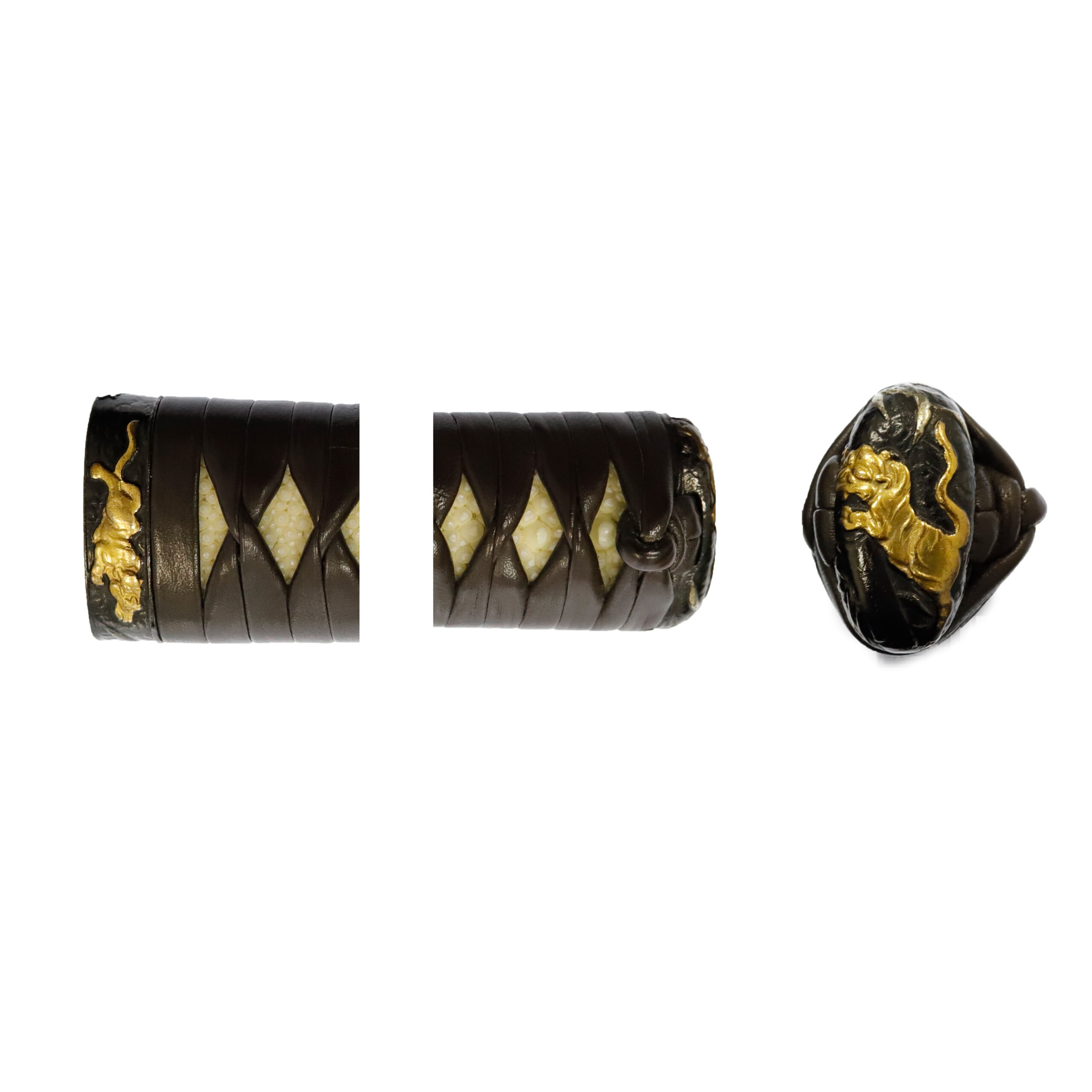
Tsuka and Menuki:Tsuka is the handle of the Japanese sword and Menuki is its decoration.
Although we cannot see the entire shape, we estimate the Botan (牡丹, peony) flower is the motif of this Menuki. The flowers, buds, and leaves are each carved with a relatively realistic expression. Peony represents happiness, wealth, nobleness, and gorgeousness. This flower pattern has been treated as a kind of good-omen motif; people regarded it as a rich harvest sign. As mentioned above, a peony is called the Botan in Japanese. When we write this flower’s name in Japanese, its second letter means mountain hermit medicine that would give us eternal youth. Based on the meaning of this letter, the peony pattern symbolizes eternal youth and longevity.
It is not a tiger but a type of lion and this flower is a famous combination design. The Kara-Jishi (唐獅子) is a classical subject and favored designing for various items since a long time ago. The Shishi (獅子) means a lion in Japanese, and the Kara-Jishi is a lion brought from the Continent to Japan in the Toh period (唐, Tang dynasty, 618-907). The Kara-Jishi typically has curly hair for its head, neck, body, and tail. In Buddhism, the Kara-Jishi is regarded as a symbol of wisdom, and the Monju Bosatu (文殊菩薩, Manjushri Bodhisattva) rides lions. According to a theory, the Kara-Jishi originates from the Komainu (狛犬, stone guardian dogs that exorcize evil spirits). There is a Houwa (法話, Buddhist monks tell the story of Buddhism in an easy-to-understand manner) that treats this Kara-Jishi and peony flower. The lion is called the king of the beasts. However, even this invincible animal has only one fear; a bug in the lion’s body. This pest grows in the lion’s hair, eventually breaking the skin and biting the flesh. Nevertheless, it dies if it is exposed to be the night dew of a peony. Therefore, the lion rests under peony flowers at night, looking for a haven. The tiger is not an endemic species of Japan but an animal introduced from the continent. Therefore, in old age, we assume that tigers were sometimes drawn without knowing their actual figure and were sometimes confused with other similar animals, such as lions. What we would like to say is that this Houwa might have inspired this handle’s sword mountings’ designs.


Tsuba and Habaki:Tsuba is the handguard for the Japanese Sword and Habaki is the equipment to make the blade not touch its scabbard inside. It prevents the blade from getting rusty and chipped.
The insects engraved on this Tsuba are probably the Hachi (蜂, bee). In Japan, beehives have long been considered to ward off misfortune and prosperous business and are sometimes displayed at entrances as lucky charms. A legend also says, “If a beehive is built under the eaves, there will be no fire.” In addition, the bee is a motif that is popular worldwide as having various spiritual connotations.
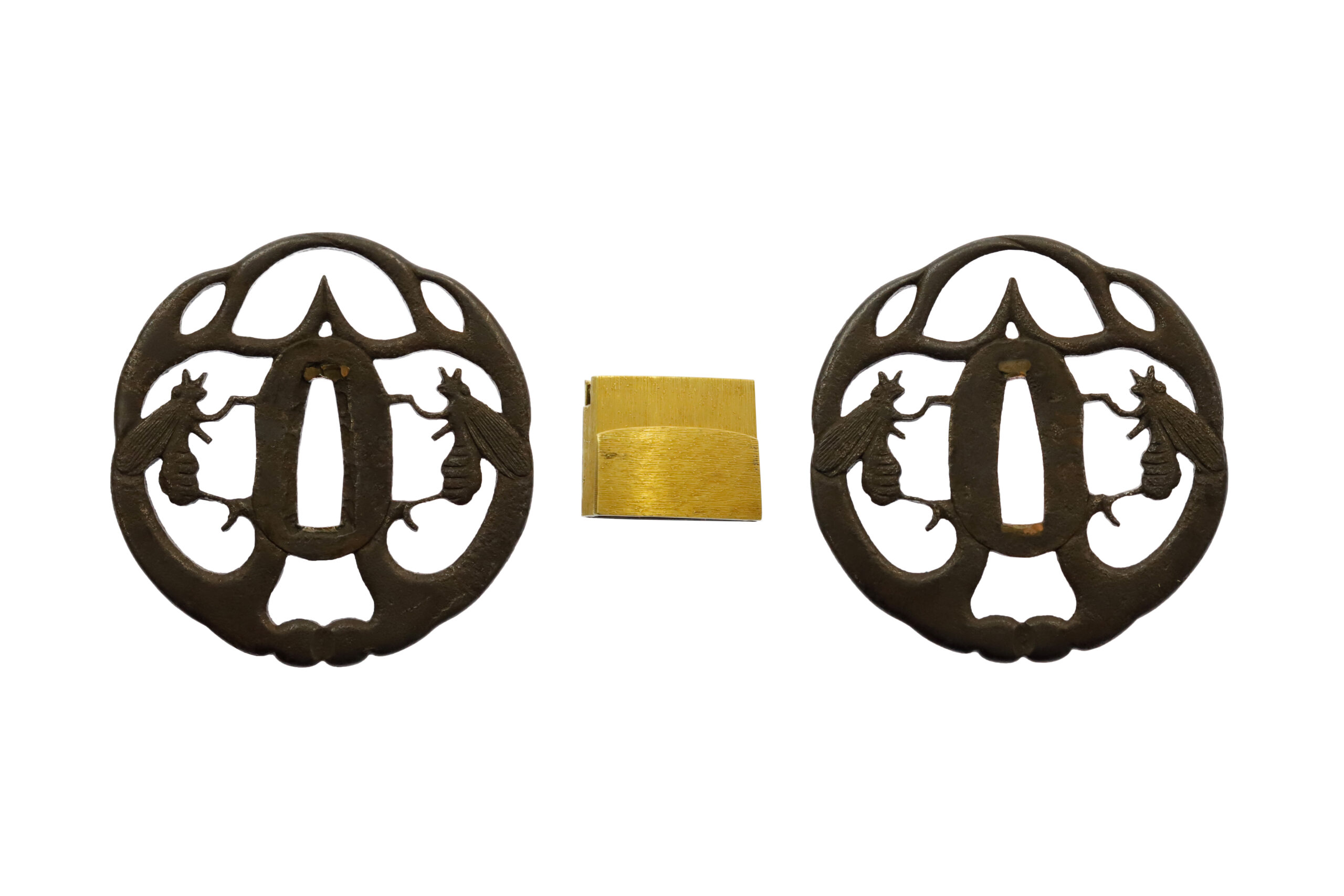
Saya: Saya is the scabbard for the Japanese sword.

Registration Number : Gifu 78109
The Board of Education in Gifu prefecture issued a registration paper for this sword . It is called Jyu Token Rui Torokusho(銃刀剣類登録証). Bunkacho(The Agency for Cultural Affairs) acknowledges a Japanese sword with this paper as a work of art.
The sword needs to be traditionally hand-forged and made of Tamahagane carbon steel to be registered in the system. With this paper, its owner in Japan can legally own an authentic Japanese sword. Based on this registration number, we will apply for its export permit.
This paper will need to be returned to the board of education when the sword is being shipped abroad, but you can receive a copy of it. An English translation of this registration paper is available on request.


—————————————————————–
【About us】
Samurai Museum is located in Tokyo, Japan, exhibiting antique artifacts related to the Samurai history. Samurai Museum Shop is the place for those who are interested in Japanese culture and craftsmanship. We deal with antique Samurai swords/armor, traditional crafts made in Japan and so on.
【Japanese Sword& Export Process】
The Japanese swords we deal with are hand-forged edged swords made in Japan. It was made from the traditional carbon steel called TAMAHAGANE(玉鋼). Samurai Museum is familiar with the proper legal procedure for an antique/ authentic Japanese sword to be exported from Japan. We have sent more than 500 Japanese swords for the past three years (~2023) to amazing owners who appreciate its historical value.
Each Japanese sword is registered under the Agency for Cultural Affairs and the Board of Education in Japan. They issue a registration paper for each Japanese sword for its owner in Japan to legally possess it. The Japanese sword with its registration paper means it was traditionally hand-forged in Japan.
To legally export the sword from Japan to other countries, we will have to apply for its permit to the Agency for Cultural Affairs(Bunkacho) and return the original registration paper to the Board of Education. It normally takes around 2-4 weeks to receive this permit after submitting required documents. And we would like you to expect at least 1-1.5 months for your order to arrive at your given address after you ordered. For more detailed info, please click here.
It is allowed for residents in Japan to own authentic Japanese swords without a special license as long as they come with registration papers. Please feel free to contact us if you are a resident of Japan, whether temporarily or permanently. We will also assist you when you leave Japan and need to obtain the export permit.
【Payment Method】
We accept payment through Stripe (Credit card), PayPal, Apple Pay or ChromePay, all of which are secure payment methods. Also, you don’t need to make an account on Stripe for the checkout. If you prefer other payment method, please contact us. After confirming your payment, we will apply for an export permit. You may either pay in JPY, USD, AUD, CAD,EUR CHF or GBP. The price is set in Japanese Yen. Prices in other currencies are automatically calculated based on the latest exchange rate.

* If the amount is above 1 million JPY, Stripe or wire transfer will be the only options for payment.
【Shipping】
We have shipped authentic Japanese swords to the USA, UK, Canada, Mexico, Germany, France, Hong Kong and Australia. If you don’t live in these countries and like to order, please contact us first before making a purchase. We offer Free International Shipping as long as we can send antique Japanese swords by EMS.
We normally ship by EMS(Express Mail Service) provided by Japan Post. We will send you a tracking number for your order as soon as we hand it to the post office. We will put 100 % insurance on the shipping document without any extra charge. Based on the total amount, there might be a duty tax or other fee for you to pay, depending on the countries. We use package cushioning to protect the item and put it in a PVC pipe, which is one of the most secure packages because of its durability.
It will normally takes 5-14 days for the item to arrive at your given address after we dispatch it. Time of delivery is estimated as accurately as possible by the carrier but does not take into account any delays beyond our control such as by inclement weather, post office holiday seasons.
* If you live in Australia and like to purchase an authentic Japanese sword, please click here to know the detail.
*Please keep in mind that due to the spread of COVID-19, there might be delays in shipping. If you like to know the detail about shipping, please feel free to ask us.

【Review】
Here is one of the reviews we received from a customer who purchased an authentic Japanese sword from us. For more reviews, please click here.
“My experience overall with the whole process was wonderful. I had many questions about the history and process to purchase these treasures. All my questions were answered very timely and complete. The staff is very knowledgeable and very well versed if any questions do arise.”
【How to make sure the condition】
Please keep in mind that what you are going to purchase is an antique item. We uploaded high resolution photos for you to check its condition thoroughly. If you like to see more photos with different angles, please feel free to contact us. We will be happy to send them to you so that you can make informed decision. It is essential for us to know that you are happy with your choice of a sword. and we are prepared to use the best of our ability to serve you.
【How To Contact Us】
Please contact us through email, Facebook Messenger or Live Chat if you have any questions. You can find each icon on the right side of the website. Please click one of them to reach us. We will reply to you within 1-2 business days.
【The Art of Nihonto (Japanese Sword)】
Samurai’s history is a profound, eloquent legacy of ancient Japanese warriors in which millions of people worldwide are being fascinated. If you like to find out the art of Nihonto, please click here.
【A Guide to Japanese Sword Maintenance】
After acquiring an genuine Japanese sword, it is also important to know how to take good care of it. Here is the special video for you. Mr. Paul Martin, Japanese sword expert, shows you how to give proper maintenance to your sword. By mastering how to clean the Japanese sword, its aesthetic beauty will last forever.
When you purchase a Japanese sword from us, you can get a Free Japanese sword maintenance kit. It comes with four tools(Choji Oil, Uchiko Whetstone Powder, Peg remover, Oil Applicator). By watching the video instruction above , you can enjoy learning how to maintain your Japanese sword while appreciating it. If you have any difficulty assembling the sword or cleaning the blade, you can feel free to contact us.


MORE ANTIQUE JAPANESE SWORD FOR SALE
SWORDS WITHOUT CERTIFICATES FOR SALE
LEARN JAPANESE SWORD TERMINOLOGY
Thank you for reading all the information on the page. If you have any difficulty choosing the right Japanese sword for you, we will be more than happy to help you find the one that speaks to you the most. Please feel free to contact us.

